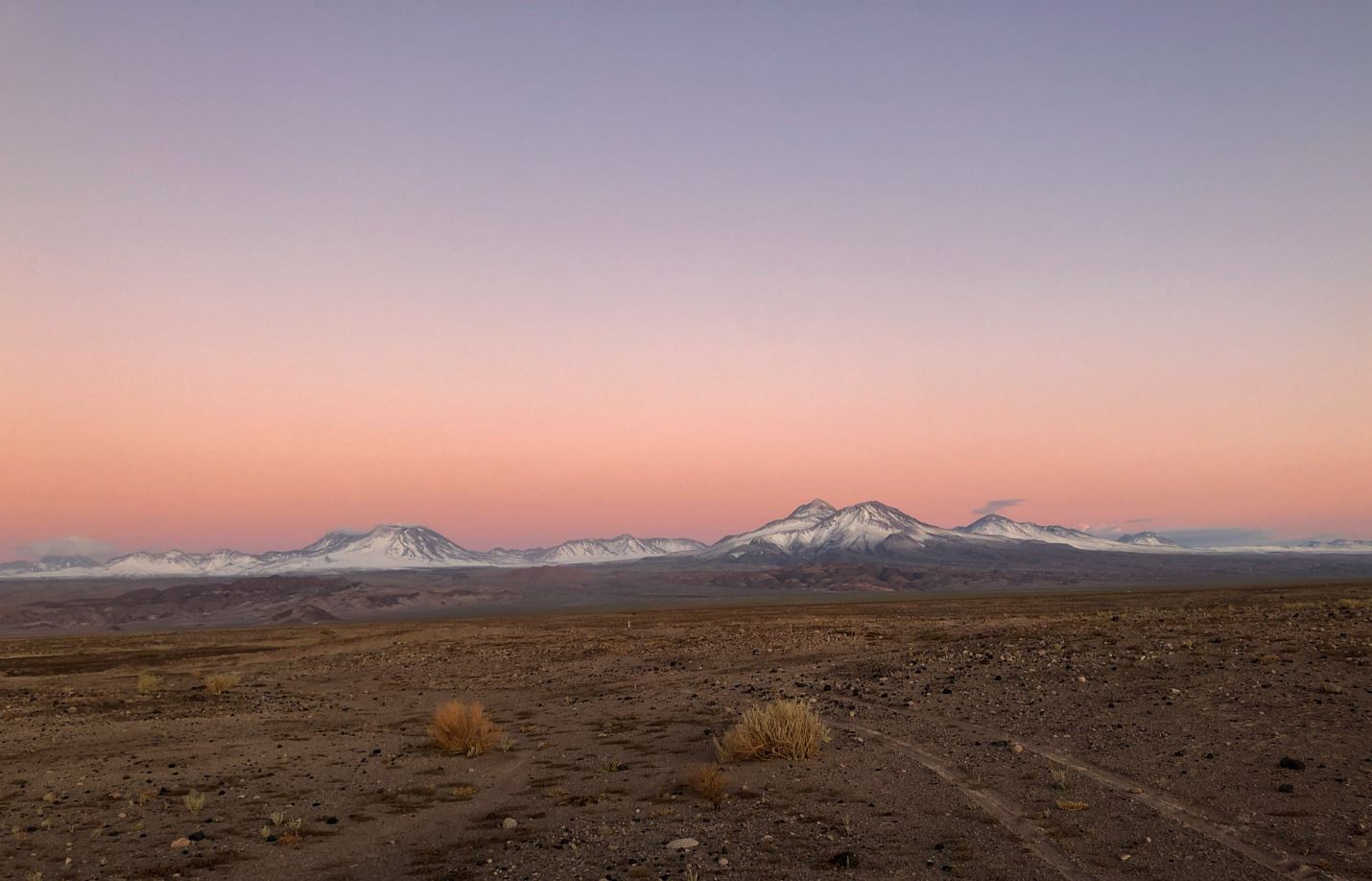Investing in Tomorrow’s Potential: Why Climate and Water Demand a More Holistic Approach
An extended version of an exclusive interview with Fady Jameel Deputy President and Vice Chairman, Abdul Latif Jameel, from the International Desalination Association magazine ‘Global Connections’, Q1/2021
The name Abdul Latif Jameel has become increasingly prominent in the energy and environmental services sector in recent years. What is your involvement in the water industry?
Abdul Latif Jameel’s core business was traditionally automotive. For over 75 years, we have enjoyed a strong relationship with Toyota Motor Corporation, which has spread across the Middle East and North Africa to Europe and Asia Pacific. In recent years, though, our most rapid international expansion has been our renewable energy and environmental services business. This includes Almar Water Solutions, which most recently entered the water services sector in Chile through the acquisition of Osmoflo SpA, and in Egypt with the acquisition of Ridgewood though Almar’s joint venture with Hassan Allam Utilities.
Almar was established in 2016 and currently operates in Europe, the Middle East, Africa and Latin America. Our other main energy and environmental services flagship business is Fotowatio Renewable Ventures, more commonly known as FRV, our solar and wind renewable energy and specialist, which is particularly active in Latin America, Australia, the Middle East and Europe. We have ambitious and significant international growth plans for both Almar and FRV over the coming years.
How engaged are you personally with the water industry?
My most obvious connection to the water industry is as an investor. Almar Water Solutions is helping to address water scarcity and water quality challenges across the globe through its investments in water treatment, water reuse, and desalination projects for municipal and industrial sectors. But from a personal perspective, my interest and involvement in the water industry goes far beyond a simply financial one.
As a committed environmental and philanthropist I’d like to consider myself what you might call an ‘activist-investor’ – using my rather unique and relatively privileged position to champion initiatives, whether commercial or philanthropic, that are able to make a tangible, but also meaningful, contribution to building a better world.
Water is a key, if not the key, critical issue both for the planet and mankind. Innovating, developing and investing in processes and technologies that enables us, as a society, to provide an adequate supply of water for our communities, industries and agriculture – in a way that doesn’t harm the environment – is one of the biggest challenges we will ever face.
Water use has increased by about 1% each year for the last 30 years, with more than two billion people now living in countries experiencing high water stress. Approximately two-thirds of the world’s population – roughly four billion people – are forced to endure water stress for at least one month each year. In my ‘home’ region of the Middle East alone, 6% of the world’s population are forced to survive on just 1% of the world’s freshwater.
I strongly believe the issues around water scarcity are simply too big to ignore.
Many of the environmental crises we have seen in recent years are manifestations of the increasing and unsustainable pressure on this most precious of our planet’s resources: extreme weather, drought, famine, wildfires and pandemics. If we concentrate only on addressing these ‘symptoms’ rather than engineering fundamental change in our relationship with water and its central role in our environmental wellbeing, these crises will not only continue, they will worsen considerably. Indeed, they are already spilling into the socio-economic realm and will inevitably drive issues such as migration and even conflict in the future.
Many people believe the climate crisis facing our planet is fundamentally a water crisis. Do you think this is accurate?
It’s impossible to talk about the climate crisis without also talking about a water crisis. After all, climate change is about the environment we live in – and other than the air we breathe, water is probably the most important element in that environment. If global temperatures rise, water temperatures also increase, ice caps melt, seal levels rise, food supplies are interrupted, oceans are polluted, coastal areas are inundated, habitats are destroyed, and so on. It is a cycle of destruction with water at the very center. On top of this, our insatiable appetite for power means we are also grappling with unsustainable demands on our energy systems, the main elements of which – oil, coal and gas – are finite, with supplies expected to run out over the next few decades.
The nexus between water, food and energy is central to the sustainable development of our society. But a growing global population, rapid urbanization, changing diets and economic growth mean that demand for all three is rising fast. Not least from agriculture, which is the largest consumer of the world’s freshwater resources, and food production and supply, which accounts for over 25% of energy use globally. The relationships between these three critical domains are inseparable. Addressing the challenges requires a holistic, cohesive and integrated approach to ensuring water and food security, sustainable energy production and viable agricultural systems worldwide.
As you rightly point out, the growing demand for water puts increasing pressure on the limited resources available. How can this best be addressed?
Desalination and wastewater treatment are probably the most advanced currently available technologies that can play an important role in overcoming this challenge. Globally, more than 300 million people already get their water from desalination plants. These include the desalination facility being developed in Al Shuqaiq, Saudi Arabia, by a consortium including our water solutions company, Almar Water Solutions. It will be one of the largest reverse osmosis desalination plants in the world once complete, with a production capacity of 450,000 cubic meters per day, supplying drinking water to 1.8 million people over 25 years, and creating 700 jobs. Similarly, in Mombasa, Almar is developing Kenya’s first large-scale desalination plant. Once complete, it will deliver more than 100,000 cubic meters of drinking water to more than a million people.
At the same time, research and innovation around wastewater reuse has been gaining momentum. Global contracted reuse capacity has almost doubled since 2010 and I expect the pace of growth to continue, if not increase. A few pathfinders are leading the way here such as California and Singapore. Currently, the global average of water reuse is still no more than around 4%, so there is massive potential for further growth, and we are seeing growing recognition that wastewater treatment can provide a cost-effective, flexible and sustainable solution to water scarcity, complementing the development of the desalination sector. This trend will be further strengthened by new EU and US wastewater re-use regulations, which help to provide a consistent international framework and raise public awareness of the benefits and standards around water reuse.
Almar Water Solutions is already transferring its leadership in desalination technology into sustainable wastewater treatment solutions. This includes a major stake in a 100,000 m3/day state-of-the-art wastewater treatment plant and sewer conveyance system at Muharraq in Bahrain. Similarly, in Egypt, where 7.3 million people have no access to safe drinking water and 8.4 million are deprived of proper sanitation, Almar is partnering with HA Utilities to develop wastewater management and other water infrastructure projects across the country.
The direction of travel is clear, and I expect to see a lot more innovation and investment activity in both the desalination and wastewater treatment sectors in the coming years, as two of the most promising solutions to the water scarcity challenge.
One of the main factors holding back investment in water technologies, historically, has been the cost, and specifically the cost of energy required to run desalination and wastewater treatment plants. How is this changing?
It is undoubtedly a cruel irony that desalination is often most uneconomical in those areas that need it most. In addition to the significant energy costs, water is heavy and expensive to transport relative to its value. This means desalination plants are typically located on the coast and near the point of use, serving relatively affluent industrial, commercial, or domestic demand, and leaving more deprived, inland areas literally ‘high and dry’. But I firmly believe there are many reasons to be positive.
Continuous innovation since the 1970s has already reduced the energy consumption of reverse osmosis desalination by a factor of 10, with costs expected to decline by up to two-thirds over the next two decades. Extensive research into pre-treatment, nano-technology filtering, and electrochemical methods promises to make desalination even more efficient, while a new generation of ‘greener’ facilities are already making desalination an ever-more sustainable solution. A solar-powered desalination system in China, for example, can provide more than 1.5 gallons of fresh drinking water per hour from one square meter of solar panel area. And there’s a non-profit organization called GivePower, which is supplying battery-driven solar-powered desalination systems to poor communities in Kenya and Haiti. I fully expect – and hope – to see more innovations like this helping to maximize the potential of desalination technologies.
More and more, with the advancement of renewable energy sources, we are also seeing small remote desalination units implemented to serve off-grid communities.
We also see renewable energy as a vital piece of the jigsaw when it comes to achieving the full potential of desalination and wastewater treatment technologies. That’s why we have embedded it in our long-term philosophy at Abdul Latif Jameel.
Through FRV, we are harnessing low carbon solutions such as wind and solar energy to generate clean energy across the globe, from Australia to Chile. And we’ve launched a dedicated team to focus on the next generation of high-performance batteries, recognizing that utility-scale power storage solutions are critical to accelerating the transition to a more dependable green energy future. Our ambition is to democratize renewable energy by going beyond the environmental argument alone and making the economics more viable to become a driver of a much wider adoption.

We’re not alone, and this transition is hopefully underway with unstoppable momentum. Eventually, we expect to see water facilities, whether desalination or wastewater treatment, co-located with renewable energy plants, bringing both sustainable energy and water supplies to communities in need across the globe.
John H. Lienhard V, who was recently appointed Dean at the IDA and joined the Board, is also the Director of the Abdul Latif Jameel World Water and Food Systems Lab (J-WAFS) at MIT. Can you tell us about the lab and its work?
J-WAFS is one of four research labs we co-founded or fund at MIT through Community Jameel, the family’s global philanthropy. The other are the Abdul Latif Jameel Poverty Action Lab (J-PAL), the Abdul Latif Jameel World Education Lab (J-WEL), and the Abdul Latif Jameel Clinic for Machine Learning in Health (the Jameel Clinic).

J-WAFS brings together some of the world’s leading researchers in water and food systems to help combat the unprecedented challenges of climate change.
When MIT and Community Jameel co-founded J-WAFS in 2014, we already recognized the impending water and food emergency and the crisis facing our society. The idea behind the lab is to facilitate and encourage the cross-fertilization of ideas and develop breakthrough research and technology that can then be commercialized in the real world, particularly in less developed markets including, for example, Africa, South and South-East Asia and Latin America. Community Jameel itself acts as a bridge between leading edge research on the one hand, and potential investors and partners on the other, leveraging the long-standing links between the Jameel family and MIT.
So far, J-WAFS has supported over 200 researchers, 21 lab projects and four start-ups or products. Among its successes are a natural low-cost water filter made from xylem wood. When plants draw up water through their roots and take it into the leaf through their xylem tissue, it can cause bubbles in the water. To get rid of these bubbles, the plants have membranes in the xylem that filter them out. The J-WAFS team showed that these same xylem membrane structures can also be used to filter water and remove bacteria. They are using the same idea to design practical, effective domestic water filters based on xylem that would cost just a few cents.
Another example is a project that uses specialized droplets — called Janus emulsions — to detect bacterial contamination in food, to bring a fast, easy, and affordable food safety sensing technology to industry and consumers. It could also potentially be used to check for contaminants in water supplies or detect spoilage organisms in a product.
One of the weaknesses of climate (and therefore water) policy in the past was the lack of reliable data on the effectiveness of different policies and initiatives. I believe J-PAL is helping to address this issue?
 Yes, that’s right. J-PAL is a global research center working to reduce poverty by ensuring that policy is informed by scientific evidence. Anchored by a network of over 190 affiliated professors around the world – and led by its Nobel prize winning founders, professors Abhijit Banerjee and Esther Duflo – J-PAL conducts randomized impact evaluations to assess policy impact.
Yes, that’s right. J-PAL is a global research center working to reduce poverty by ensuring that policy is informed by scientific evidence. Anchored by a network of over 190 affiliated professors around the world – and led by its Nobel prize winning founders, professors Abhijit Banerjee and Esther Duflo – J-PAL conducts randomized impact evaluations to assess policy impact.
Its main focus, as its name suggests, is on reducing global poverty, but given that the world’s poorest are most vulnerable to, and disproportionately affected by, our treatment of our environment, climate change is firmly on its radar, too. So, it has established a specific Environment, Energy, and Climate Change program – the King Climate Action Initiative – to measure the real-world impacts of energy and environmental policies, particularly on energy access, pollution reduction, and climate change mitigation and resilience.
In addition to supporting policymakers in applying evidence from randomized evaluations to their work, J-PAL also provides policy insights that explain the general lessons emerging from the research and condenses the results from evaluations in policy publications and evaluation summaries, making this invaluable data accessible to the widest possible audience.
It is a really exciting program and we are already seeing some fantastic results from its work in the climate change and water policy arena.
Our world has changed a lot in the past months due to the pandemic. What do you think will be the impact of this on the water industry?
The pandemic will have a significant impact on the water industry, both directly and indirectly. It is likely to affect consumption patterns and levels. With more people staying at home due to lockdown restrictions, domestic consumption is likely to have increased. At the same time, with many industries negatively affected by the crisis, industrial usage is likely to have decreased. Agricultural is less likely to have been affected.
However, I believe the real impact will be indirect, in the shape of increased awareness and urgency around climate change and the environmental sustainability of our society.
The pandemic can be seen as confirmation that we are the catalysts for many of the environmental changes we are witnessing on our planet. Indeed, if impact of coronavirus teaches us anything, it is that preventing a recurrence of this catastrophic outbreak will take a whole new way of thinking about how we access, process and consume nature’s resources – none of which are more precious than water.
I think this is likely to lead to increased and I hope accelerating investment in cleaner, more energy efficient desalination technologies, and also drive a dramatic expansion of the wastewater treatment industry. Even more so given recent improvements in the regulatory framework, exemplified by the new EU regulations.
How optimistic are you for the future of the water industry and its wider role in shaping our response to the climate crisis?
I’m an optimist by nature, so I’m hopeful we can take the necessary steps to deliver on the potential of the water industry to sustain our communities, protect our planet and safeguard our future.
The journey will not be easy. We must all work together – the water industry, investors, NGOs, governments, researchers, communities – to drive forward the necessary advances to secure safe, clean, sustainable water supplies for all.
The water crisis is everyone’s responsibility.
And I firmly believe that if we prioritize the water challenge, establish the policy and fiscal frameworks to encourage investment and innovation, and foster a spirit of collaboration and partnership, we can build a water industry with the capacity and commitment to play a critical role in strengthening water security and global development, helping to secure a sustainable future for all.
 Read the cover interview with Fady Jameel in the Q1 2021 issue of Global Connections by the International Desalination Association here.
Read the cover interview with Fady Jameel in the Q1 2021 issue of Global Connections by the International Desalination Association here.





 1x
1x


 Added to press kit
Added to press kit


